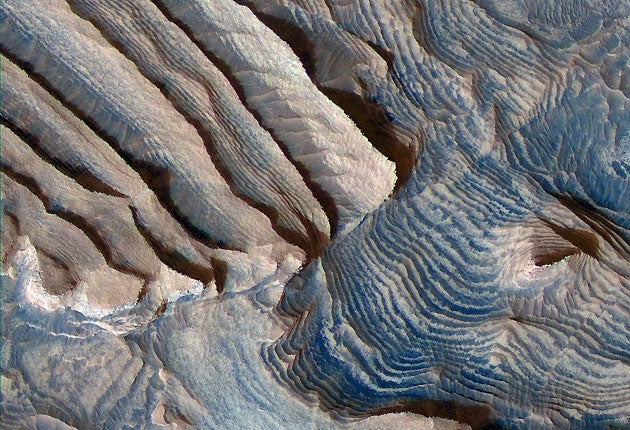Your support helps us to tell the story
From reproductive rights to climate change to Big Tech, The Independent is on the ground when the story is developing. Whether it's investigating the financials of Elon Musk's pro-Trump PAC or producing our latest documentary, 'The A Word', which shines a light on the American women fighting for reproductive rights, we know how important it is to parse out the facts from the messaging.
At such a critical moment in US history, we need reporters on the ground. Your donation allows us to keep sending journalists to speak to both sides of the story.
The Independent is trusted by Americans across the entire political spectrum. And unlike many other quality news outlets, we choose not to lock Americans out of our reporting and analysis with paywalls. We believe quality journalism should be available to everyone, paid for by those who can afford it.
Your support makes all the difference.Mars may have once been both cold and wet, researchers said today, suggesting a freezing Martian landscape could still have produced water needed to sustain life.
There has been debate over the issue because with some researchers believing water likely formed many features of the planet's landscape and others pointing to evidence indicating that early Mars was cold with temperatures well below the freezing point of water.
Using a computer model, Alberto Fairen of Universidad Autonoma in Madrid and colleagues showed that both could have been possible because fluids containing dissolved minerals would have remained liquid at temperatures well below 273 degrees Kelvin - the freezing point of pure water.
"Our results are compatible with Mars lander and orbiter data and with climate modelling, and suggest a cold and wet early Mars," they wrote in the journal Nature.
The presence of water on Mars is a hot topic for scientists. They have presented strong evidence of huge deposits of frozen water at the Martian poles and point to geological features that indicate large bodies of water have flowed on the planet's surface in the distant past.
Other scientists have said images and computer simulations strongly suggest a landslide of sand and gravel are more likely explanations for the bright deposits in gullies that have been proposed as strong evidence of water flow.
Water is a key to the question of whether life, even in the form of microbes, ever existed on Mars. On Earth, all known forms of life require water.
Feiren and colleagues, including scientists from NASA's Ames Research Center in California, chose compositions based on weathered basalts for the Martian fluids in their model to match the chemical compositions of rock found at Mars landing sites.
This analysis showed that a number of minerals could have lowered the melting point of water in a frozen Martian environment and help explain the early Mars climate paradox, they said.
"The stability against freezing of Martian fluids can explain saline water activity on the surface of Mars at mean global temperatures well below 273 Kelvin," they wrote.

Join our commenting forum
Join thought-provoking conversations, follow other Independent readers and see their replies
Comments